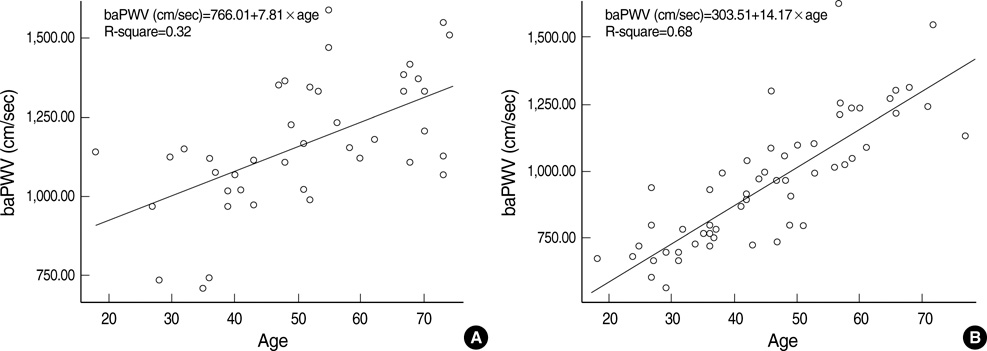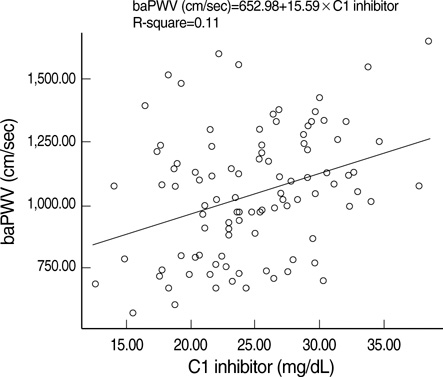J Korean Med Sci.
2009 Oct;24(5):831-836. 10.3346/jkms.2009.24.5.831.
The Relationship between Brachial Ankle Pulse Wave Velocity and Complement 1 Inhibitor
- Affiliations
-
- 1Department of Surgery, Masan Samsung Hospital, Sungkyunkwan University School of Medicine, Masan, Korea. jongkwon.park@gmail.com
- KMID: 1782002
- DOI: http://doi.org/10.3346/jkms.2009.24.5.831
Abstract
- Complement 1 (C1) inhibitor is an acute phase protein with anti-inflammatory properties. The aim of the present study was to elucidate the relationship between brachial ankle pulse wave velocity (baPWV), the parameter of arterial stiffness, and C1 inhibitor. One hundred subjects were randomly enrolled in this study. Data about baPWV, age, gender, hypertension, smoking, and body mass index (BMI) were measured. Blood tests for total cholesterol, low density lipoprotein, high density lipoprotein, triglycerides, hemoglobin A1c, erythrocyte sedimentation rate, C-reactive protein, complement 3, and C1 inhibitor were performed. Based on the Pearson correlation, the C1 inhibitor showed a positive relation to the baPWV (P<0.001). Multiple regression analysis revealed the significant predictors of baPWV were not only the conventional risk factors of arteriosclerosis and/or atherosclerosis, such as age (P<0.001), gender (P<0.001), hypertension (P<0.001), and BMI (P=0.006), but also the acute phase protein, C1 inhibitor (P=0.025). In conclusion, C1 inhibitor is associated with arterial stiffness through its association with increased inflammation.
MeSH Terms
-
Adolescent
Adult
Age Factors
Aged
Ankle/blood supply
Ankle Brachial Index
Blood Flow Velocity/physiology
Blood Pressure/physiology
Body Mass Index
Brachial Artery/*physiology
Complement C1 Inhibitor Protein/*metabolism
Elasticity
Female
Humans
Male
Middle Aged
Predictive Value of Tests
Regression Analysis
Risk Factors
Sex Factors
Figure
Reference
-
1. Zanker KS. General introduction to innate immunity: Dr. Jekyl/Mr. Hyde quality of the innate immune system. Contrib Microbiol. 2008. 15:12–20.2. Caliezi C, Wuillemin WA, Zeerleder S, Redondo M, Eisele B, Hack CE. C1-Esterase inhibitor: an anti-inflammatory agent and its potential use in the treatment of diseases other than hereditary angioedema. Pharmacol Rev. 2000. 52:91–112.3. Kalter ES, Daha MR, ten Cate JW, Verhoef J, Bouma BN. Activation and inhibition of Hageman factor-dependent pathways and the complement system in uncomplicated bacteremia or bacterial shock. J Infect Dis. 1985. 151:1019–1027.
Article4. Woo P, Lachmann PJ, Harrison RA, Amos N, Cooper C, Rosen FS. Simultaneous turnover of normal and dysfunctional C1 inhibitor as a probe of in vivo activation of C1 and contact activatable proteases. Clin Exp Immunol. 1985. 61:1–8.5. Kostner KM, Fahti RB, Case C, Hobson P, Tate J, Marwick TH. Inflammation, complement activation and endothelial function in stable and unstable coronary artery disease. Clin Chim Acta. 2006. 365:129–134.
Article6. Jani B, Rajkumar C. Ageing and vascular ageing. Postgrad Med J. 2006. 82:357–362.
Article7. Wykretowicz A, Gerstenberger P, Guzik P, Milewska A, Krauze T, Adamska K, Rutkowska A, Wysocki H. Arterial stiffness in relation to subclinical atherosclerosis. Eur J Clin Invest. 2009. 39:11–16.
Article8. Ridker PM, Silvertown JD. Inflammation, C-reactive protein, and atherothrombosis. J Periodontol. 2008. 79(8):Suppl. 1544–1551.
Article9. van Popele NM, Grobbee DE, Bots ML, Asmar R, Topouchian J, Reneman RS, Hoeks AP, van der Kuip DA, Hofman A, Witteman JC. Association between arterial stiffness and atherosclerosis: the Rotterdam Study. Stroke. 2001. 32:454–460.10. Yamashina A, Tomiyama H, Takeda K, Tsuda H, Arai T, Hirose K, Koji Y, Hori S, Yamamoto Y. Validity, reproducibility, and clinical significance of noninvasive brachial-ankle pulse wave velocity measurement. Hypertens Res. 2002. 25:359–364.
Article11. Nicoletti A, Caligiuri G, Hansson GK. Immunomodulation of atherosclerosis: myth and reality. J Intern Med. 2000. 247:397–405.
Article12. Kullo IJ, Gau GT, Tajik AJ. Novel risk factors for atherosclerosis. Mayo Clin Proc. 2000. 75:369–380.
Article13. Rosner B. Fundamentals of Biostatistics. 1995. 4th ed. Belmont, California, USA: Duxbury Press.14. Kim DH, Kim J, Kim JM, Lee AY. Increased brachial-ankle pulse wave velocity is independently associated with risk of cerebral ischemic small vessel disease in elderly hypertensive patients. Clin Neurol Neurosurg. 2008. 110:599–604.
Article15. Xu Y, Wu Y, Li J, Ma W, Guo X, Luo Y, Hu D. The predictive value of brachial-ankle pulse wave velocity in coronary atherosclerosis and peripheral artery diseases in urban Chinese patients. Hypertens Res. 2008. 31:1079–1085.
Article16. Lappin D, Whaley K. Regulation of C1-inhibitor synthesis by interferons and other agents. Behring Inst Mitt. 1989. (84):180–192.17. Zuraw BL, Lotz M. Regulation of the hepatic synthesis of C1 inhibitor by the hepatocyte stimulating factors interleukin 6 and interferon gamma. J Biol Chem. 1990. 265:12664–12670.
Article18. Prada AE, Zahedi K, Davis AE 3rd. Regulation of C1 inhibitor synthesis. Immunobiology. 1998. 199:377–388.
Article19. Windfuhr JP, Alsenz J, Loos M. The critical concentration of C1-esterase inhibitor (C1-INH) in human serum preventing auto-activation of the first component of complement (C1). Mol Immunol. 2005. 42:657–663.
Article20. Johnson AM, Alper CA, Rosen FS, Craig JM. C1 inhibitor: evidence for decreased hepatic synthesis in hereditary angioneurotic edema. Science. 1971. 173:553–554.
Article21. Donaldson VH, Rosen FS. Action of complement in hereditary angioneurotic edema: the role of C'1-esterase. J Clin Invest. 1964. 43:2204–2213.22. Natali A, L'Abbate A, Ferrannini E. Erythrocyte sedimentation rate, coronary atherosclerosis, and cardiac mortality. Eur Heart J. 2003. 24:639–648.
Article23. Buono C, Come CE, Witztum JL, Maguire GF, Connelly PW, Carroll M, Lichtman AH. Influence of C3 deficiency on atherosclerosis. Circulation. 2002. 105:3025–3031.
Article24. Mallika V, Goswami B, Rajappa M. Atherosclerosis pathophysiology and the role of novel risk factors: a clinicobiochemical perspective. Angiology. 2007. 58:513–522.
Article25. Bisoendial RJ, Kastelein JJ, Stroes ES. C-reactive protein and atherogenesis: from fatty streak to clinical event. Atherosclerosis. 2007. 195:e10–e18.
Article26. McLaren JE, Ramji DP. Interferon gamma: a master regulator of atherosclerosis. Cytokine Growth Factor Rev. 2009. 20:125–135.
Article27. Zahedi K, Prada AE, Davis AE 3rd. Transcriptional regulation of the C1 inhibitor gene by gamma-interferon. J Biol Chem. 1994. 269:9669–9674.
Article28. Tomiyama H, Koji Y, Yambe M, Shiina K, Motobe K, Yamada J, Shido N, Tanaka N, Chikamori T, Yamashina A. Brachial--ankle pulse wave velocity is a simple and independent predictor of prognosis in patients with acute coronary syndrome. Circ J. 2005. 69:815–822.29. Hung CS, Lin JW, Hsu CN, Chen HM, Tsai RY, Chien YF, Hwang JJ. Using brachial-ankle pulse wave velocity to associate arterial stiffness with cardiovascular risks. Nutr Metab Cardiovasc Dis. 2009. 19:241–246.
Article30. Farrar DJ, Green HD, Bond MG, Wagner WD, Gobbee RA. Aortic pulse wave velocity, elasticity, and composition in a nonhuman primate model of atherosclerosis. Circ Res. 1978. 43:52–62.
Article
- Full Text Links
- Actions
-
Cited
- CITED
-
- Close
- Share
- Similar articles
-
- Relationship between Cardiac Autonomic Neuropathy and Brachial-ankle Pulse Wave Velocity in Type 2 Diabetics
- The Relationship of Pulse-wave Velocity with Carotid Intima-media Thickness and Carotid Artery Distensibility
- Correlation of Arterial Stiffness and Bone Mineral Density by Measuring Brachial-Ankle Pulse Wave Velocity in Healthy Korean Women
- Pulse wave velocity and ankle brachial index in normal adolescents
- Uric Acid Level Has a J-Shaped Association with Arterial Stiffness in Korean Postmenopausal Women




